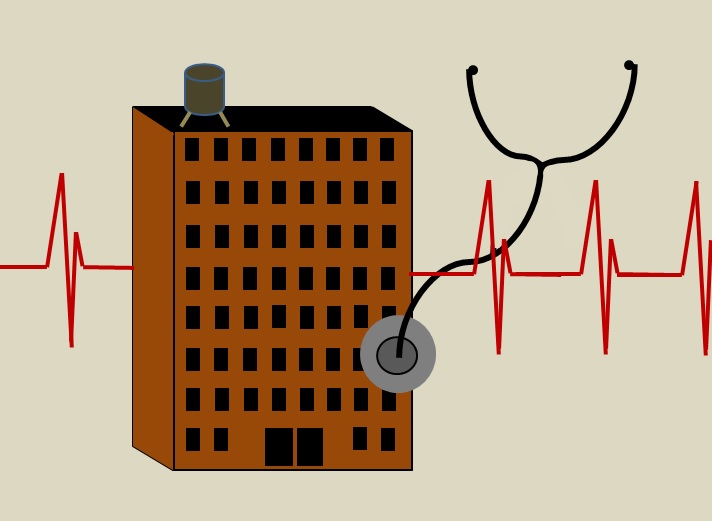
Steps from the 4 train in the lobby of a Bronx residential building, 30 tenants met with housing advocates to discuss how they can improve their living conditions. The tenants’ echoing voices resounded throughout the lobby, cornered by crumbling walls and leaks which formed puddles of water on the ground. Children cackled and pointed as roaches scurried across the floor—had their childhood innocence created a curtain of protection to these hazardous living conditions? One tenant stood up and said, with a mix of fatigue and anger, “I have mold and the landlord hasn’t done anything about it!” His neighbors’ affirming murmurs carried throughout the lobby. There at that meeting, the tenants’ grievances laid bare how poverty, race, housing, and environmental justice intersect.
For years the environmental movement was not racially diverse and largely ignored the hyper-concentration of environmental problems in low-income communities and communities of color. Civil rights activists have worked to raise awareness of and challenge structural racial discrimination in environmental policy-making, siting of toxic facilities, and enforcement. New York City has a long history of battling environmental racism. Most notably, in 1969, the Puerto Rican nationalist group the “Young Lords” blocked Third Avenue with garbage buildup to protest the city’s failure to clean up waste. The move, known as Garbage Offensive, was one of the first of its kind to shed light on how governmental agencies neglected to address environmental conditions in low-income communities of color.
Despite increased awareness of how environmental issues intersect with race and poverty, many people ignore some of the greatest environmental hazards such as mold, mildew, asbestos and lead because they occur in the home rather than outdoors. These environmental hazards cannot be treated with a fresh coat of paint or a swipe of bleach. These conditions are persistent and deep within the structures of the building and often require extensive treatment, which many low-income tenants cannot afford.
As a result, low-income Bronx tenants (55 percent of whom are Hispanic and 43 percent of whom are African American) are often resigned to living with poor conditions, which pose severe health risks. Lead, a symptom of peeling paint and crumbling walls, has been shown to cause neurological illnesses and may be connected to Attention Deficit Hyperactivity Disorder in children. Exposure to asbestos can lead to lung cancer and other respiratory ailments. Mold has been shown to exacerbate asthma and other respiratory conditions.
Moreover, many of these environmental hazards threaten children’s health in particular. According to the National Institute of Health, children in the Bronx are 30 percent more likely to be sensitized to allergens, which exacerbate asthmatic symptoms. At 8.9 percent, the Bronx’s overall asthma rate is one of New York City’s highest. Children in the Bronx are even at greater risk experiencing asthma around 17 percent of the time, which is 8 times the national average. These heightened rates of asthma are undeniably linked to the prevalence of environmental health triggers in the borough’s neighborhoods.
Low-income Bronx tenants are particularly vulnerable to these environmental hazards in the home for a number of reasons. Language barriers, race and poverty often collide to deter residents from fighting for their housing rights. Unlike indigent criminal defendants, people are not entitled to a free attorney in civil proceedings. Accordingly, most tenants are unrepresented in eviction proceedings in housing court, a context in which tenants may seek a court order requiring their landlord to make repairs. Even for the most seasoned tenant advocates, navigating housing court is overwhelming. Moreover, many Bronx residents, especially those with limited English proficiency, are uncomfortable signing legal documents. Therefore, exposing a landlord’s inaction in dealing with these living conditions can place tenants from marginalized communities at an even greater risk for retaliation, such as eviction.
To combat these environmental hazards in Bronx homes, MFY Legal Services and New York Lawyers for the Public Interest (NYLPI) have partnered to launch the Campaign for Better Bronx Housing. We aim to engage, empower, and educate Bronx residents by increasing awareness of their housing rights. According to a 2010 survey by Bronx Health Link, only 39 percent of respondents said they received information on environmental risks and pregnancy. The Bronx’s long history of community mobilization for environmental justice concerns and the need to organize around healthy homes, makes MFY and NYLPI’s efforts both necessary and urgent. As Bronx tenants wrestle with looming rent increases and developers staking claims to gentrifying areas, substandard and dangerous living conditions hold Bronx families hostage. Our campaign seeks to continue the trajectory of efforts in New York City to shed light on environmental injustice for poor households.
Jeffrey Bohn is a Housing Paralegal at MFY Legal Services and Sola Stamm is the Health Justice Community Organizer/Taconic Fellow at New York Lawyers for the Public Interest









One thought on “CityViews: Why We Are Campaigning for Healthier Bronx Housing”
Pingback: Why We Are Campaigning for Healthier Bronx Housing | New York Lawyers for the Public Interest